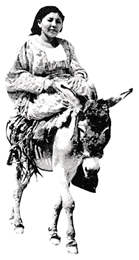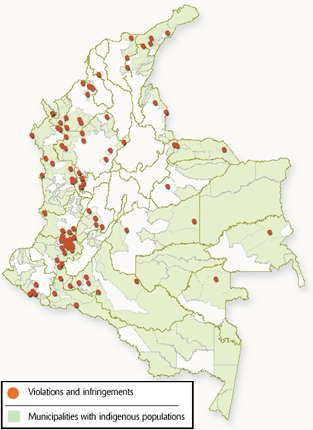|
 The
indigenous population of Colombia, currently estimated at nearly a million
persons -close to two per cent of the country's population, forming 82
peoples, has been profoundly affected by the escalating armed conflict,
and is the victim of threats, persecution, murders, kidnappings and displacement.
This is confirmed by the general trends in the information provided by
both state bodies and civil society organizations. The study of the situation
of indigenous people is made all the more difficult by the fact that the
sources of data are inaccurate and insufficient, their scope is limited,
and underestimation is frequent. Therefore, they can only be used in a
complementary way. The
indigenous population of Colombia, currently estimated at nearly a million
persons -close to two per cent of the country's population, forming 82
peoples, has been profoundly affected by the escalating armed conflict,
and is the victim of threats, persecution, murders, kidnappings and displacement.
This is confirmed by the general trends in the information provided by
both state bodies and civil society organizations. The study of the situation
of indigenous people is made all the more difficult by the fact that the
sources of data are inaccurate and insufficient, their scope is limited,
and underestimation is frequent. Therefore, they can only be used in a
complementary way.
Figures provided by the Administrative Department of Security, DAS, a
government body, and CINEP - Justice and Peace, two non-governmental organizations,
indicate an upward trend in the number of violations of the right to life
of indigenous people. CINEP - Justice and Peace figures show that indigenous
people were victims, more frequently in 2000 than in 1999, of politically
motivated murders. Also, as regards infringements of IHL, they were victims
of intentional homicides and injuries inflicted on protected persons.
|
MUNICIPALITIES
AFFECTED BY LARGE NUMBERS OF VIOLATIONS OF HUMAN RIGHTS OF INDIGENOUS
PEOPLE, AND INFRINGEMENTS OF IHL
1996 - JULY 2001
|
| Departamento |
Municipio |
Departamento |
Municipio |
| Antioquia |
Apartado |
Cordoba |
San
Carlos |
| Antioquia |
Betania |
Cordoba |
Tierralta |
| Antioquia |
Chigorodo |
Choco |
Bagado |
| Antioquia |
Dabeiba |
Choco |
Bojaya |
| Antioquia |
El
Bagre |
Choco |
El
Carmen de Atrato |
| Antioquia |
Frontino |
Choco |
Jurado |
| Antioquia |
Ituango |
Choco |
Nuqui |
| Antioquia |
Maceo |
Choco |
Riosucio |
| Antioquia |
Murindo |
Choco |
San
Francisco de Quibdo |
| Antioquia |
Mutata |
Choco |
Unguia |
| Antioquia |
Toledo |
Guajira |
Albania |
| Antioquia |
Turbo |
Guajira |
Maicao |
| Antioquia |
Yondo |
Guajira |
Riohacha |
| Bolivar |
El
Carmen de Bolivar |
Magdalena |
Fundacion |
| Boyaca |
Cubara |
Magdalena |
Santa
Martha |
| Caldas |
Riosucio |
Meta |
Mesetas |
| Caqueta |
Florencia |
Meta |
Puerto
Gaitan |
| Caqueta |
Milan |
Nariño |
Cuaspud |
| Caqueta |
San
Jose del Fragua |
Nariño |
Cumbal |
| Cauca |
Buenos
Aires |
Nariño |
Guachucal |
| Cauca |
Caldono |
Nariño |
Tuquerres |
| Cauca |
Caloto |
Norte
Santander |
Cucuta |
| Cauca |
Corinto |
Norte
Santander |
Tibu |
| Cauca |
Inza |
Norte
Santander |
Toledo |
| Cauca |
Jambalo |
Risaralda |
Belen
de Umbria |
| Cauca |
La
Sierra |
Risaralda |
Mistrato |
| Cauca |
Paez |
Risaralda |
Pueblo
Rico |
| Cauca |
Piendamo |
Risaralda |
Quinchia |
| Cauca |
Popayan |
Sucre |
Sampues |
| Cauca |
San
Sebastian |
Tolima |
Coyaima |
| Cauca |
San
Vicente del Caguan |
Tolima |
Natagaima |
| Cauca |
Santander
de Quilichao |
Tolima |
Ortega |
| Cauca |
Silvia |
Valle |
Buenaventura |
| Cauca |
Sotara |
Valle |
Cali |
| Cauca |
Toribio |
Valle |
Florida |
| Cesar |
Bosconia |
Valle |
Jamundi |
| Cesar |
San
Juan |
Valle |
Pradera |
| Cesar |
Valledupar |
Arauca |
Arauca |
| Cordoba |
Chinu |
Arauca |
Saravena |
| Cordoba |
Cienaga
de Oro |
Casanare |
Yopal |
| Cordoba |
Montelibano |
Putumayo |
Mocoa |
| Cordoba |
Puerto
Libertador |
Putumayo |
Puerto
Asis |
| Cordoba |
Purisima |
Putumayo |
Villagarzon |
| Cordoba |
San
Andres Sotavento |
Guainia |
Inirida |
| Vaupes |
Mitu |
|
|

|
According to the
Administrative Department of Security, DAS, the indigenous people are
victims of both the self-defense groups and subversive organizations,
particularly the FARC. This clearly shows to what extent indigenous peoples
suffer the consequences of the armed conflict. Beyond the categories established
by the DAS, however, and taking account of the large number of indigenous
persons allegedly murdered by unknown individuals and common criminals,
it could be concluded that the figures for indigenous people killed as
a consequence of the actions of illegal armed organizations are higher
than previously thought.
|
HOMICIDES
OF INDIGENOUS PEOPLE PER YEAR *UNTIL JUNE 2001
|
|
|
|
Source:
Administrative Department of Security, DAS
Processed by the Observatory of the Presidential Program for Human
Rights and IHL.
|
The geographical
distribution of violations of the right to life of indigenous people and
infringements of IHL coincides with the location of their territories.
A negative impact has been particularly strong among certain ethnic groups,
and is attributable chiefly to the activities of self-defense and guerrilla
groups. The worst-affected groups include the Embera-Katío and
the Embera-Chamí, the victims of homicides and massacres, among
other violations, in the departments of Córdoba, Antioquia and
Chocó; the Nasa -several Páez Indians fell among the victims
of the upper Naya massacre, and the Guambiano of Cauca; the U´wa
of Arauca, Boyacá and Northern Santander; the Arhuaco, the Kogi,
the Arsario and the Kankuamo of Cesar, Magdalena and Guajira, inhabitants
of the Sierra Nevada de Santa Marta; the Wayuu of Guajira; the Coreguaje
of Caquetá; the Inga and the Siona of Putumayo, the Zenú
of Córdoba; and other ethnic groups of Guainía and Vaupés.
|
INDIGENOUS
PEOPLE KILLED IN THE CONFLICT
|
|
|
|
Source:
CINEP - Justice and Peace, Noche y Niebla Journal
Processed by the Observatory of the Presidential Program for Human
Rights and IHL.
|
State action as regards
the protection and guarantee of human rights through the administration
of justice includes the penalization of violations of the rights of indigenous
communities. The Human Rights Unit of the Prosecutor General's Office
is currently conducting 146 procedures for violations of the rights of
indigenous people, 119 of which are cases of homicide. As far as the progress
of these processes is concerned, in July 2001 there were 85 investigations
at a preliminary stage, 11 indictments has been returned, 4 restraining
orders had been issued, one case was at a trial stage, and one more had
been transferred to a military criminal court.
|
VIOLATIONS
OF HUMAN RIGHTS OF INDIGENOUS PEOPLE
BY PERPETRATOR
JANUARY 1999 TO JUNE 2001
|
|
|
|
Source:
Administrative Department of Security, DAS
Processed by the Observatory of the Presidential Program for Human
Rights and IHL.
|
|



![]()